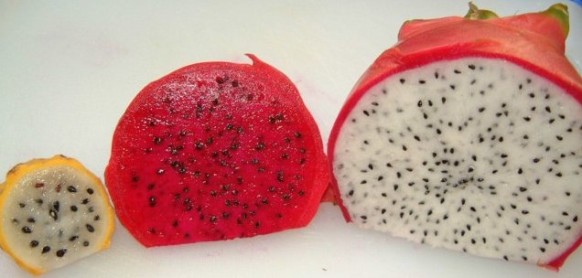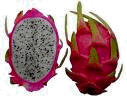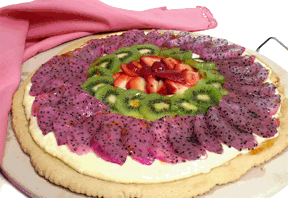The only RED Dragon Fruit (aka pitaya or pitahaya or strawberry pear) that I am used to were those with RED SKIN and WHITE FLESH (Hylocereus undatus). It tasted a bit bitter to me and I didn’t like the after-taste. Other reports said it tastes like a mix of kiwi fruit and watermelon.
I didn’t take notice of it other than eating what was being served to me until a friend shared about its benefits and salad recipe. As it is beneficial to health, I posted it here under “Why Dragon Fruit?“. Only then did I notice that there is a RED SKIN Dragon Fruit with RED FLESH (Hylocereus polyrhizus) variation.
Now I also found out that there is YELLOW SKIN variety (Selenicereus megalanthus) and with only white flesh.
The taste of the red flesh variety is sweeter and the after taste is great to me. Other reports said it tastes like raspberries. I will usually eat 1 whole fruit (about 300-500gm) willingly which I normally won’t with other fruits. However, it is not that common as they are in Malaysia.
Yesterday, at a neighborhood market, I saw red Dragon fruit selling at a stall and as usual, only white flesh variety was on sale at S$1.50 (approx. US$1) per fruit. When asked, the seller said that white flesh variety is preferred by most consumers because those who consumed are paranoid about the reddish variation of urine or stools that they will pass out after consumption. They are apparently worried that the red flesh is a result of genetic modification, adding of artificial coloring or preservatives, etc.
This red “symptom” happened only if one eats quite a bit, a fruit or so as I have experienced myself.
Exporters in Malaysia for pitaya explained that the color is 100% natural and that it is not genetically modified or dyed red. The color comes from natural pigments known as hylocerenin and isohylocerenin and is also known to have natural florescent property. That makes the red flesh variety prettier when served.
If one were to eat a lot of blackberries or those fruits with such pigmentation, the output into the toilet bowl will be similar. However, how many people eat 0.5kg or more of such berries?
Yet, red flesh variety is more expensive and they are sold here in kilogram (S$4-S$5 per kg) instead of by quantity. I recently bought 2 red flesh fruits for close to S$4.00 (approx US$2.80).
Malaysian exporters justified the higher cost to its benefits. One reported that “Eating red-fleshed pitaya fruit was reported to increase bone density, prevent colon cancer and ease constipation. This can explained why red pitaya cost more expensive as compared to white pitaya“.
It was also reported that the red flesh variety is believed to be rich in antioxidants and has an exceptionally high content of soluble fiber. It is considered a good source of vitamin C and its vitamin C is more easily absorbed than vitamin C from a pill supplement. Some bloggers swear that it helps to lower blood glucose levels in type 2 diabetes.
Well, anyone out there got a health benefit comparison report between the red and white flesh? Ahh, don’t forget the yellow skin.
Meanwhile, I will still go for the Red Flesh Red Dragon Fruit whenever possible.



